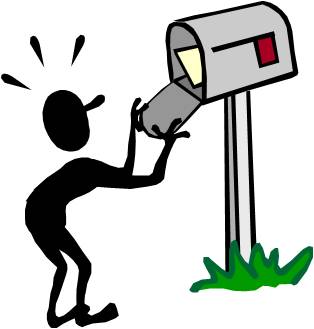Entries from December 2013 ↓
December 30th, 2013 — Sales Letters, sales writing

Technology may well be moving at a mind-boggling pace, but there will always be room for the humble sales letter within your marketing armoury.
These staples of the marketing world haven’t really changed. Other fads come and go, but your sales letter will always follow the same recipe.
This article looks at how you can make your sales letters stronger and boost their effectiveness.
1. Strong start
If you don’t capture your reader’s attention from the outset, there’s only once place your letter will end up – in the bin.
A great way to make an impact is by using a headline above the salutation in your letter. But make sure it is relevant to the rest of the letter and makes a big impact.
If you decide not to use a headline, all the pressure is on your first sentence.
2. Problems
One of the most powerful ways to structure a sales letter is the ‘problem/solution’ format.
Start out by identifying the problem your reader has and then go on to solve it with your product or service.
Using this method highlights the issue they are facing, shows that you care (that’s where a bit of empathy helps) and that you can make their problem go away – you’re great.
3. Benefits
Your reader doesn’t care what features your product has, all they want to know is how it’s going to make their life easier. Think about what’s important to them; do they want more time, to save money, be more popular? Whatever it is, focus on that as the main benefit of your product.
4. Strong offer
Although the benefits are crucial, your reader is going to buy your offer, not your product. For example, if you and a competing opticians were sending out sales letters and you just told them about your latest range of designer specs, but your competitor did the same but with a ‘buy one get one free’ offer, you can bet your Granny that the reader will go for their offer and not your glasses.
5. Guarantee
It’s also important that you back up your offer with a strong guarantee.
People want to be given peace of mind and a money back guarantee (or something along those lines) will give them the warm and fuzzy feeing they need to be persuaded to part with their hard earned cash.
6. Call to action
Just as any good sales man will ask a customer for an order, your sales letter has to do the same.
Tell them to buy and make it clear how they can do so. Make sure your phone number is displayed prominently so they can easily get in touch.
7. Easy to respond
If your call to action involves them sending off an order form, make sure it’s easy to complete and that you enclose a stamped addressed envelope. If they are to phone through an order, make sure your phone number is easy to find. If you want them to order online, give them clear instructions.
These 7 tips will help you create strong sales letters. Don’t forget, everything your customer needs to know must be in the letter because they can’t ask you questions. Give them an offer they can’t refuse and then make it easy for them to buy. That’s really all there is to it.
Author: Sally Ormond
December 23rd, 2013 — Google, website copywriter, website copywriting

OMG – have you heard the latest?
The way you write for the web is changing so fast. There are Google’s perpetually changing algorithms, new social media platforms springing up, +1s, shares, tweets, status updates…
How on earth are you supposed to know how to write your web copy when the goal posts keep moving?
Whoa!
Hang on there.
Who’s moving the goal posts?
Sure, with every new tweak Google makes, or when a social media platform becomes flavour of the month, there are a shed load of blog posts published that claim to have unearthed the one secret you need to know to get Google to love your content.
Poppycock.
The only thing they’re doing is driving traffic to their blogs. Day after day, thousands of salivating web writers and business owners pour over their words like hungry caterpillars (I loved that book) looking for the trick that is going to propel them to the top of the search pile.
Well, I hate to burst your bubble, but there is no magic secret.
Sure, there are things, such as Google Authorship, that will help, but the only thing that will help you get and retain (that’s the hard bit) good rankings is high quality content.
High quality content is the answer
I know you’re probably fed up reading that the only way to impress Google is through high quality content – but there’s a reason you keep reading it – because it’s true.
Forget about writing for the search engines, keywords and all those other fads you read about. There is and always will be, only one thing that works and that is creating content that is:
- Well written
- High in quality
- Interesting
- Relevant to your reader
- Full of benefits
- Full of useful information
- Not full of you and your business
- Written naturally
- Not stuffed with keywords
Yes, it’s a boring answer, but it is the right one.
There are no tricks or short cuts, just good old fashioned, high quality writing.
Sorry to ruin your day, but the truth needed to be told.
By Sally Ormond
December 20th, 2013 — copywriting, copywriting tips, marketing, website copywriter, website copywriting

“We don’t like the first draft, it’s too marketing; it sells our services too much.”
That is a real life response from a copywriting client.
Yes, I was stunned too.
Apparently, the copy had to be more ‘jargonised’ and in the language of ‘high business’ and not focused on what they can do for their clients.
No. That’s not how it works.
Your website is your sales tool
Your website is available to people all over the world, 24/7/365.
It exists for one reason only – to tell readers what you can do for them and how their lives (or businesses) will be richer by using your products or services.
How do you do that?
Through high quality website copywriting that focuses on your reader and tells them the main benefits of what you do.
If your website focuses on you and is full of jargon, at best it tells the world your company exists, but that’s it.
Great, you exist. So what? I’m going to use these other guys who have taken the time to tell me about how their service is going to help me.
You are missing a trick – a potentially very lucrative trick – if you ignore this advice.
How to market through website copy
As mentioned earlier, you have to remember that:
- Your website is a sales tool
- It exists to tell people what you can do for them
- It is not a soap box from which you can rave about your company
The copy that you write has to be:
- Focused 100% on your reader
- In the second person so it ‘speaks’ to your reader
- Focused on the benefits you provide
- Engaging and interesting
And it should all be topped off with a strong call to action telling the reader to get in touch, buy now, sign up, or whatever action it is you want them to take.
Don’t make the mistake of thinking your website is there to tell the world about you. That type of thinking is lame, boring and a disaster waiting to happen.
Please, please use your website as it should be used. Make it all about your reader and not about you.
Thanks for allowing me to get that off my chest. I feel much better now.
Author: Sally Ormond, copywriter at Briar Copywriting Ltd
Twitter | Facebook | Google+
Image courtesy of Clare Bloomfield/FreeDigitalPhoto
December 18th, 2013 — social media, social networking
Over the years social media has changed – a lot. Not only has the variety and functionality of the platforms increased so has the public’s buy-in, making social media part of every day life.
There are oodles of posts out there that report on user statistics, but one I stumbled across on Econsultancy really blew my mind.
It looks at the growth of social media over the past three years.
Rather than ramble on about it, here’s what they found:
Twitter
- In 2010 is had 75m user accounts, of which about 15m were active users
- In 2013 it has 883m user accounts and 232m monthly active users
- In 2010 the average number of tweets per day was more than 27m
- As of August 2013 Twitter users were posting around 500m tweets per day, which means about 5,700 tweets a second
- In 2010 the average number of tweets per hour was around 1.3m
- In 2013 Twitter users send out around 20.8m tweets per hour
LinkedIn
- In 2010 it had more than 50m members worldwide
- In 2013 it has 259m members after increasing its user base by 40% in a year
- In 2010 there were 11m LinkedIn users across Europe
- In 2013 it has more than 57m European members and more than 74m across EMEA
Facebook
- In 2010 Facebook had 350m monthly active users
- In 2013 it has 1.19bn monthly active users
- In 2010 50% of active users logged into Facebook each day, meaning at least 175m users every 24 hours
- In 2013 Facebook claims to have 727m active daily users, meaning 61% of users log on every day
- In 2010 65m users accessed Facebook through mobile devices
- In 2013 874m monthly active users used Facebook mobile products as of September 3rd 2013
- In 2010 there were more than 3.5bn pieces of content shared each week on Facebook
- In 2013 there are 33.25bn pieces of content shared every week
Flickr
- In 2010 Flickr hosted more than 4bn images
- In 2013 it has competition from a wide range of different social networks and there are no statistics as to the number of images it hosts, but one estimate puts it close to 8bn
Wikipedia
- In 2010 Wikipedia had 14m articles and 85,000 contributors
- In 2013 it has more than 30m articles in 287 languages and 125,900 active registered users
It’s only when you see comparative stats like those that you fully grasp how social networking has grown over the years.
Irrefutable proof that, if you don’t already have a social media marketing strategy, you need one.
December 16th, 2013 — case studies, Testimonials
 Author: Sally Ormond, Copywriter and MD at Briar Copywriting Ltd. Follow her on Twitter and Google+
Author: Sally Ormond, Copywriter and MD at Briar Copywriting Ltd. Follow her on Twitter and Google+
Testimonials are wonderful things.
They offer potential clients an insight into your service and approach and illustrate the benefits of your product/service in a real life situation.
Listing them on your website, or dotting them amongst the rest of your copy is OK, but you could make more of them.
Turning testimonials into stories
There’s nothing better than a good old-fashioned story to get your readers engrossed.
Let’s face it the testimonials you receive from customers are like the wrap up of a story. They’re just missing the beginning, middle and protagonist.
But if you were to add that information, hey presto, your testimonial suddenly turns into a case study.
Weaving a story around the testimonial is easy; just make sure it’s factual.
First, set the scene – give some background to it, who is the client and why did they come to you? This is where you explain the problem they had.
Now in comes the protagonist – that’s you, or at least your product or service. Think about why they came to you (don’t make this bit up, if you know write about it, otherwise skip it). Write about how you approached the problem and what you did to solve it.
The happy ending – now your reader wants to know the outcome. This is the bit they’re concerned about; what did your solution do for your customer? Hopefully, the testimonial you received has a bit more substance to it than just “they were really nice and helped me, thank you.” In this section you want to show the reader how your solution helped, using their testimonial as a summary of the whole case study.
Now, your testimonial has become a story that shouts about your service, giving it a real life context that is meaningful and that your reader can relate to.
Plus, it’s a great way to add fresh content to your website.









